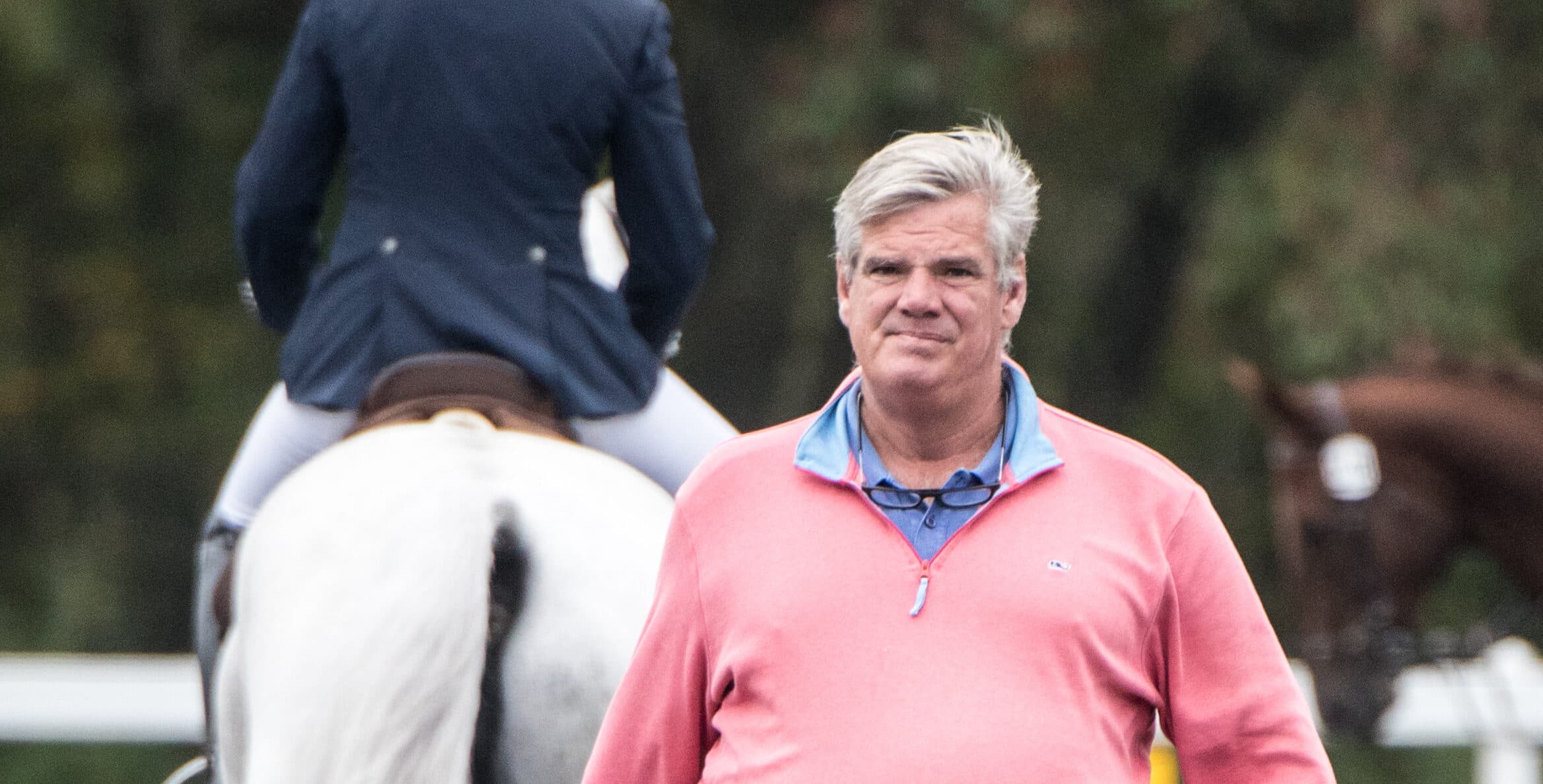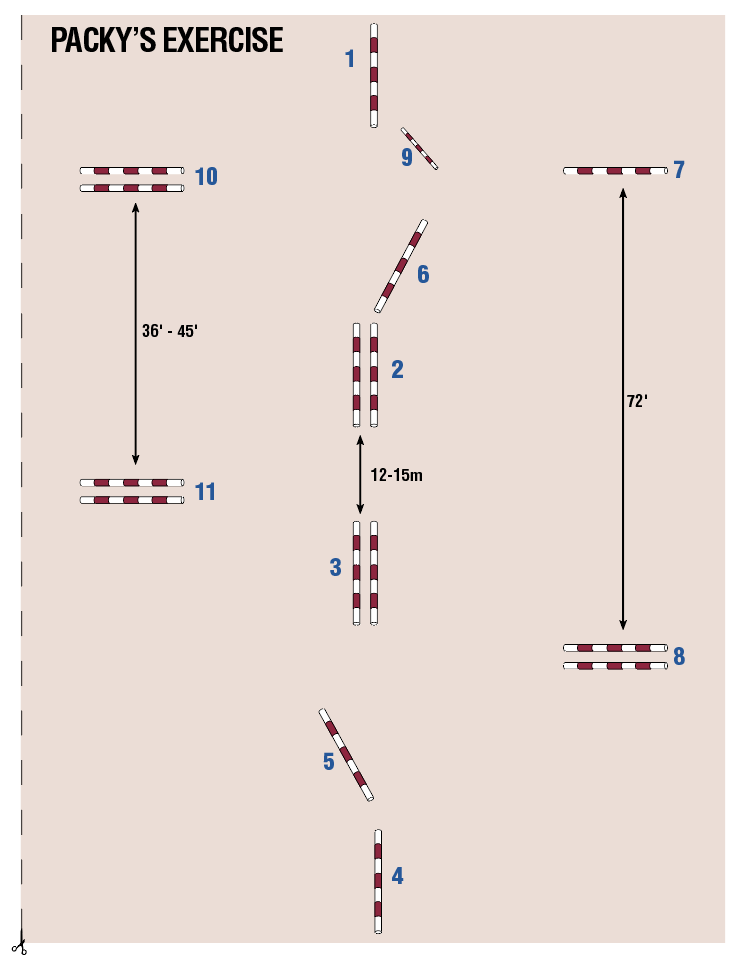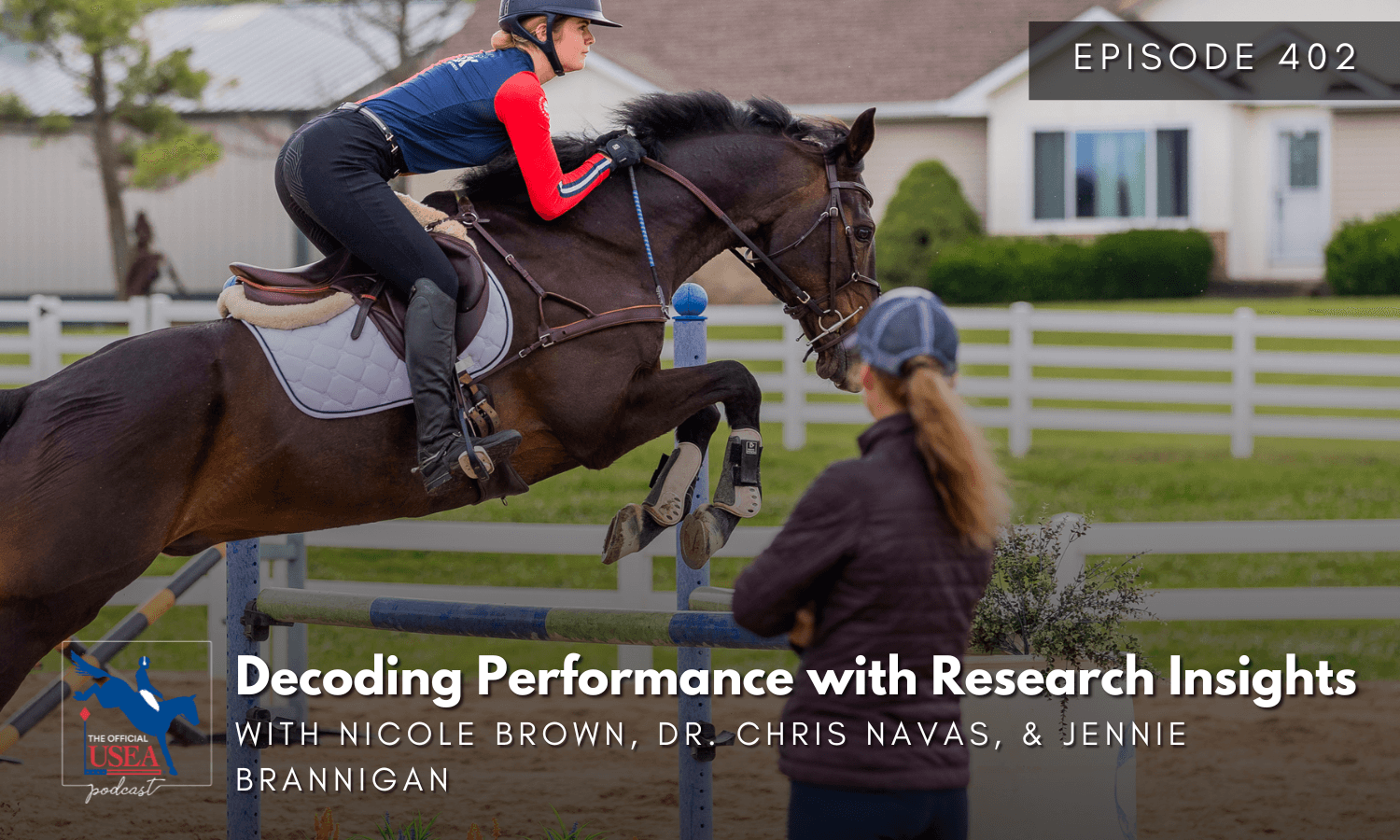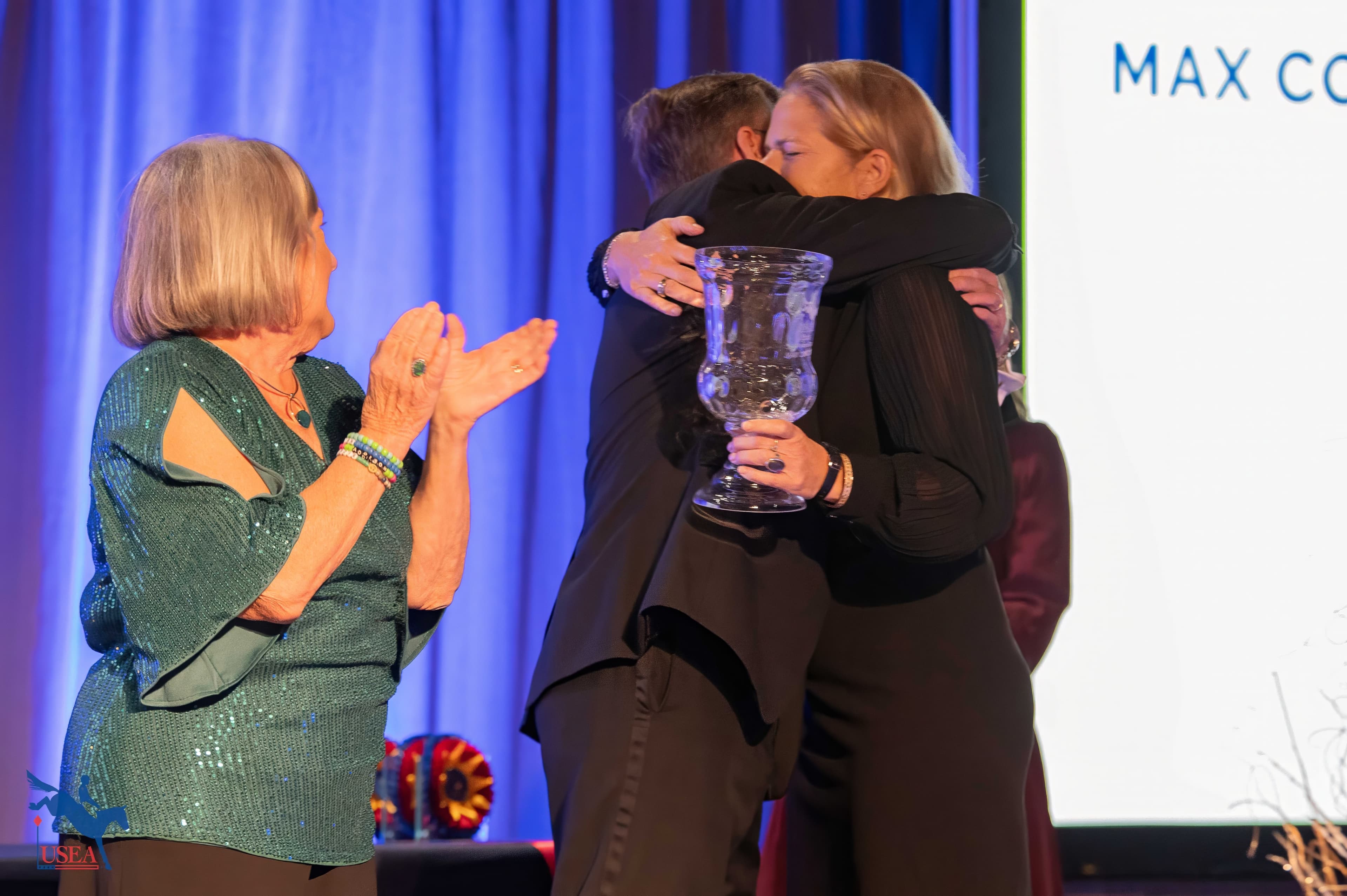Grid Pro Quo with Packy McGaughan

Ready to spice things up this winter training season? Do you want to use being stuck in the arena as an opportunity to fine tune your riding? In this series, we are revisiting some of our favorite Grid Pro Quo articles from Eventing USA to help you use the off-season to your advantage and keep you and your horse in tip-top shape for when it's time to get back out there. Click here to check out other past Grid Pro Quo exercises!
WHY:
In the early 2000s I took a group of students to watch the USEF Medal Finals at the Pennsylvania National Horse Show. In this particular year, judges George Morris and Kip Rosenthal also designed the course, which seemed deceptively simple on paper but proved to be quite challenging throughout the competition. The base of their course was four jumps across the ring as a serpentine of four obstacles. The remainder of the course only had two other jumps, a triple bar and a skinny. Interestingly enough, nearly 100 of the 265 competitors were flat out eliminated in the first round. And what was the issue? The majority of the eliminated riders could not ride the turns effectively or see a forward distance to any of the jumps. The 180-degree turns caused the rider a great deal of trouble when asked to keep a steady rhythm through the course. The eventual winner, Maggie Jayne, came into the ring with a positive, forward-thinking attitude and put in a near flawless round.
While sitting there watching, I immediately knew that I would want to figure out how to utilize this in my own arena when teaching. And since then, I often have a version of this course set up in my arena. I have adapted the course to meet current standards of our sport over the years. While the diagram provided here does require a lot of jumps, standards, and space, it can easily be adapted to fit within your arena. If you do have a limited amount of space to work with, I would start with the four jumps down the centerline (jumps 1-4), then add the remaining jumps in this order until you run out of standards: bending lines of verticals (jumps 5-6), two-stride oxer line (jumps 10-11), vertical to oxer line (jumps 7-8), and finally the wedge (jump 9). At the end of the day, these are all exercises we use to rehearse for the major competitions, which is why you will often find this set up in my arena a few weeks before the big spring and fall three-day events.
When you are setting up jumps on related distances, you should always work off of a 12-foot stride. If you are training on an incorrect stride, then you won’t be successful at a show. Investing in a measuring tape will pay off in spades at the end of the day.
Also, from a purely practical standpoint, this is a great exercise to set up in your arena because it is meant to be worked through over a course of several jump schools. So you can set it up once and not have to move jumps for several weeks, which certainly has its benefits!
If you’re preparing for a major competition, you will often find related distances on a straight line of four to seven strides, related distances on a bending line of five to eight strides, and jumps off of sharp turns. While traditional grids are good for correcting the horse’s jumping style and the rider’s timing, this set up has everything you need to prepare for your next big competition, whether it is the Beginner Novice championships or the Kentucky CCI4* (now CCI5*-L).
From a trainer’s perspective, I love to set up exercises that keep the rider thinking and there is just enough to do with this set up that it’s impossible to get bored. And as the riders at that Medal Finals learned, the only way to be successful with this exercise is to keep your horse forward and in front of your leg between the fences.
HOW:

Depending on your level, you can start your jump school in a variety of ways. But before starting this exercise, remember your two rules and what they represent:
Rule #1: Always jump on a straight line. Never angle the jumps. This ensures that you utilize your space properly and don’t cut turns.
Rule #2: Always fix your canter lead before turning. Never turn on the incorrect lead. This ensures that you have your horse supple in both directions, as you cannot expect to find distances if your horse is not supple.
Renowned course designer Roger Haller used to talk about course design in terms of the dressage test the riders were required to do for their level. For Beginner Novice riders, they should be able to execute a jump off of a 20-meter circle. As you move up the levels, you should be able to execute jumps off of tighter turns, and start to incorporate your different canters – collected, working, and extended – into your courses. Eventers often run into trouble because we have to cross train, so riders aren’t able to perfect a single phase. The biggest obstacle is going from a cross-country canter to a proper show jumping canter. By practicing all of your canters on a regular basis, you will set yourself up better for success.
I do like to set the bar a little higher for the lower-level riders, and have found that most Beginner Novice riders and horses can execute a jump off of a 15-meter circle. Additionally, all riders and horses should be able to pick up the canter correctly on both leads and maintain a steady rhythm through a series of basic patterns. Throughout this exercise, riders will learn to be more effective and efficient in the use of their aides, as you need both qualities to execute a successful show jumping round.
Once you are ready to start working through the exercise, I like to start by jumping everything individually to simply show the horses the jumps and make sure they aren’t scared of anything. Once they confidently jump each jump at least once, I will start on the five-loop serpentine. Just remember your two rules while you’re working through the exercise. Also remember that there is no time frame for this exercise. This is your time to be really picky and master each piece before moving on to the next. I firmly believe that we need to hold ourselves to a higher standard as riders, and there’s no better time to start practicing perfection than now. Perfection can become habitual if it is the standard that we hold ourselves accountable to.
As discussed earlier, this exercise will most likely expose any tendency for your horse to lose engagement, balance, or accuracy when jumping through turns. Oftentimes riders will pull on the reins to adjust the tempo, in turn diminishing the horse’s pace to a state where it can’t jump effectively or where the rider can’t find an appropriate distance. Just remember that the training scale is there for a reason, and every part of riding, regardless of the discipline can relate back to it. There are only eight strides between each of the centerline jumps, but if you rely on your rein aides you will most likely end up with 10-11 strides. On the flip side, there are those horses that will land off of a fence and want to run and play. Either of these problems can only be corrected by the rider holding the rhythm in one place. It is the rider’s responsibility to tell the horse what to do, and only through repetition will the horse begin to understand that this is the rule.
Once you have worked your way through the centerline serpentine, you are ready to add in some of the other pieces. I like to start with approaching fence 5 out of the short side on the right lead and then bending left to fence 6. Remember your two rules though: be straight to the jumps and on the correct lead before you change your bend! From here you can add in the remaining pieces depending on what you need to work on. The two-stride of oxers (fences 10-11) will help your horse create a nice shape over the fences, while the vertical-and-oxer line (fences 7-8) will tell you if all your hard work on maintaining a steady rhythm is working. And finally the wedge (fence 9) will tell you if you and your horse can focus on a single spot and jump a skinny-faced obstacle. Throughout the exercise, your horse needs to be adjustable on both the straight lines and through the turns, and as a rider you need to be able to control your leads. Otherwise, you will have rails down, plain and simple.
As you start to put courses together, try to count your strides between each fence, even the ones not on related distances. Then after you’re consistently getting a certain number of strides between two fences, play with that number a bit. Just be sure that you don’t simply pull back on the reins to create an increased number of strides. Be sure to keep your forward thinking regardless of the number of strides you’re working on.
Another thing to keep in mind while working your way through this exercise is that it is not about the height of the jumps or type of jumps. Whether you are jumping 18” cross-rails or 3’9” square oxers, the exercise will have the same effect. And if you are struggling at all, you can even master the exercise with poles on the ground before moving on to jumps with height. I find this particularly helpful with young horses, as it teaches them to step over an obstacle and keep moving. And while it is my feeling that you should practice over fences that are fully dressed, complete with flowers, panels and brush, you should also be able to jump simple fences with no filler. This is all part of teaching to the test, but making sure you don’t skip any steps along the way.
About Packy McGaughan
A popular instructor in Area II, Packy McGaughan operated Banbury Cross Farm in Clarksburg, Maryland. The farm was developed into a premier training, breeding, and boarding facility, specializing in eventing, dressage, hunters, and equitation. McGaughan was a member of the 1987 Pan American Gold Medal Team and produced numerous horses and riders to the highest level of the sport. He was a top instructor in Area II for both juniors and adult amateurs, and was often found at area events coaching riders of all ages and levels. McGaughan unexpectedly passed away in March 2020.














